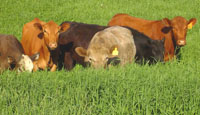|
| |

Midwest Graziers Seek to Capitalize on Nutritional Benefits of
Pasture-Raised Products
|

cows graze on the farm of Dan Specht, a beef and pork producer in
McGregor, Iowa, who was one of 16 participants in the CLA study |
Last summer, in response to interest from beef producers, NRCS grazing
specialist Jim Ranum incorporated information about health-promoting fatty acids
in grass-based cattle into his monthly pasture walks in northeast Iowa. The
information, published as part of a Sustainable Agriculture Research and
Education (SARE)-funded study measuring the presence of those acids – conjugated linoleic (CLA) and omega-3 – prompted a few farmers to switch to a pasture-based
system for their animals.
“People are trying to get a little better price for their product and are
looking at the CLA/health issue angle,” said Ranum, who distributed the SARE
report and an Iowa State University brochure about health-promoting fatty acids. Customers “want an all-natural, healthier product and the interest is there from
producers wanting to get into that type of market.”
Ranum was on the receiving end of information generated by the Northeast Iowa
Resource Conservation & Development (RC&D) council, which paired with Iowa State University researchers on a SARE-funded
project assessing CLA concentrations. Farmers in Iowa and Wisconsin, aware that
health-conscious consumers are interested in increasing their intake of
health-promoting fatty acids in meat and dairy, asked their local RC&D council to help measure the presence of conjugated linoleic (CLA) and omega-3.
Linolenic acid, an omega-3 fatty acid, has an anti-inflammatory effect in the
body, said Don Beitz, an ISU professor of animal science and biochemistry, which
may lessen heart disease. In lab tests on animals, CLAs helped prevent cancer
and heart disease, decreased obesity and improved bone health.
Project partners split groups of animals on 16 participating farms to compare
CLA content of milk and beef raised on pasture versus conserved forages. Their
results confirmed that beef and dairy products from grazing animals contain
higher CLA content than food from non-grazing animals: 3- to 4-fold greater in
milk and 1.5 to 2 times greater for beef.
“Producers who participated in the project and other local farmers who have
started raising and selling grass-fed beef that is high in CLA have a strong
market” for their products, said Lora Friest, NRCS coordinator of the Northeast
Iowa RC&D.
Dan Specht, a beef and pork producer in McGregor, Iowa, saw a dramatic
difference in CLA content in beef from steers raised 100 percent on pasture. “There was a large difference between a high grain diet and forage-based with
some grain finishing, but there was a huge difference when we eliminated grain
and went to whole grass diet,” said Specht, who participated in the study.
While he used to sell his beef to a cooperative, he has eliminated grain from
the steers’ diets and now sells his product with a “grass-fed” label at various
markets for a premium price. “It was a demand-driven change,” Specht said. “I’m
sensitive to my bottom line and what I can make money on, and the greatest
demand out there is for grass-fed organic beef.”
Ranum, the NRCS grazing specialist, is continuing to promote the CLA information
to producers through such popular farmer venues as the Upper Midwest Grazing
Conference. Some beef producers with whom he works hope to switch from partial
pasture to a complete grass diet. “They’re working toward that,” he said.
About SARE
Since 1988, SARE has helped advance farming
systems that are profitable, environmentally sound and good for communities
through a nationwide grants program. The program, administered by
CSREES and
USDA, funds projects and
conducts outreach designed to improve agricultural systems and natural
resources.
NRCS field office professionals frequently collaborate on SARE-funded projects
and are valuable partners to the SARE program. NRCS staff serve on SARE’s
national Operations Committee, on regional Administrative Councils, on State
committees and are actively engaged as technical advisers and collaborators on
SARE-funded research grants around the U.S.

For more information, visit
the SARE website or for more information about the regional SARE programs, click on the region
area of the map below.
Your contact is Diana Friedman, SARE
research associate, at 301-504-6422.
| | |
